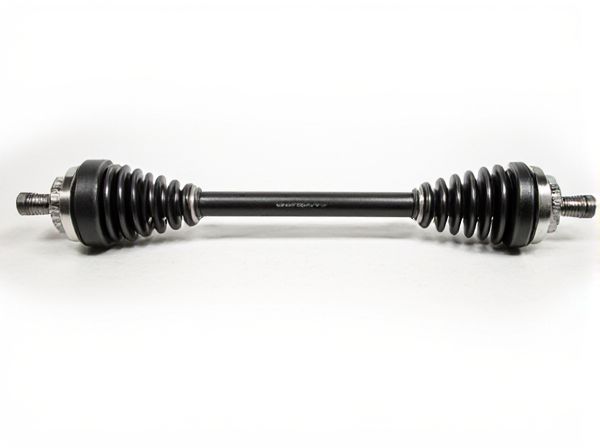
Photo illustration: Stub Axle vs Drive Axle
A stub axle is a non-driving axle that supports the wheel and allows it to rotate, primarily found on the front wheels of a vehicle for steering purposes. The drive axle transmits power from the differential to the wheels, enabling motion by delivering torque. Understanding the difference helps you maintain your vehicle's performance and optimize handling based on its drivetrain configuration.
Table of Comparison
| Feature | Stub Axle | Drive Axle |
|---|---|---|
| Function | Supports wheel and enables steering | Delivers engine power to wheels |
| Location | Front wheels, typically in steering system | Rear wheels in rear-wheel drive, front wheels in front-wheel drive |
| Power Transmission | No power transmission, only supports wheel | Transmits torque from differential to wheels |
| Components | Spindle, kingpin, steering knuckle | Axle shaft, differential, constant velocity joints |
| Load Bearing | Supports vertical load and steering forces | Supports vehicle weight and transmits driving force |
| Application | In steering wheels and non-driven wheels | In driven wheels for propulsion |
Introduction to Stub Axle and Drive Axle
Stub axles serve as pivotal components in vehicle suspension systems, connecting the wheel hub to the suspension and allowing for steering motion. Drive axles transmit engine torque from the differential to the wheels, facilitating vehicle movement and supporting load-bearing functions. Both axles are crucial for vehicle stability and performance, with the stub axle primarily handling steering dynamics and the drive axle managing power delivery.
Definition of Stub Axle
A stub axle is a critical component in a vehicle's suspension system, serving as the mounting point for the wheel and allowing it to pivot for steering. Unlike the drive axle, which transmits engine torque to the wheels for propulsion, the stub axle primarily supports the wheel hub and brake assembly without transmitting power. Commonly found in front-wheel steering mechanisms, the stub axle enables controlled directional movement crucial for vehicle handling.
Definition of Drive Axle
The drive axle is a key automotive component responsible for transmitting torque from the differential to the wheels, enabling vehicle movement. Unlike the stub axle, which supports the wheel and allows steering, the drive axle directly handles propulsion forces and torque delivery. Drive axles are typically found in rear-wheel or four-wheel drive vehicles, playing a critical role in powertrain efficiency and traction control.
Key Functions of Stub Axle
Stub axles play a critical role in vehicle steering systems by supporting the wheel hubs and allowing for smooth rotation and articulation during turns. These axles bear vertical loads and enable wheel movement independent of the drive axles, which transmit engine power to the wheels. Their design ensures stability and precise control, essential for effective handling and safe maneuvering.
Key Functions of Drive Axle
The drive axle transmits engine torque to the wheels, enabling vehicle propulsion and supporting the weight of the vehicle under drive conditions. It houses critical components such as the differential or final drive, allowing wheels to rotate at different speeds during turns. Unlike the stub axle, which primarily supports wheel mounting and steering without power transmission, the drive axle is essential for motion and torque distribution in vehicles.
Structural Differences Between Stub and Drive Axles
Stub axles are typically shorter, supporting wheel hubs and allowing for steering movement, with a simpler design consisting of spindles and mounting points for wheels and brakes. Drive axles are structurally more robust, incorporating components such as differential gears, CV joints, or universal joints to transmit engine torque to the wheels, enabling vehicle propulsion. The key structural difference lies in the drive axle's integration with the drivetrain system for power delivery, whereas the stub axle primarily serves as a non-driven, load-bearing component for wheel rotation and steering.
Applications and Usage Scenarios
Stub axles primarily support the vehicle's weight and enable steering by connecting the wheel to the suspension system, commonly used in front-wheel applications of passenger cars and light trucks. Drive axles, integral to the drivetrain, transfer torque from the differential to the wheels, predominantly found in rear-wheel drive and four-wheel drive vehicles for enhanced traction and handling. Off-road vehicles, SUVs, and heavy-duty trucks frequently utilize drive axles to manage higher torque demands, while stub axles remain essential for precise wheel alignment and maneuverability.
Advantages of Stub Axle vs Drive Axle
Stub axles offer enhanced maneuverability and ease of maintenance due to their simpler design and reduced weight compared to drive axles. They provide improved steering response in vehicles by allowing independent wheel movement, which is crucial for tight cornering and off-road conditions. Stub axles also contribute to lower unsprung mass, resulting in better ride comfort and reduced wear on suspension components.
Common Issues and Maintenance Tips
Stub axles often face issues such as bearing wear, misalignment, and frequent loosening of wheel nuts, requiring regular lubrication and torque checks to ensure proper wheel support and steering stability. Drive axles commonly experience problems like CV joint failure, leaking axle seals, and shaft bending, necessitating routine inspection for grease leakage, replacement of worn joints, and effective seal maintenance to prevent drivetrain damage. Both axles benefit from timely servicing, including cleaning, proper lubrication, and monitoring for unusual noises or vibrations to extend vehicle safety and performance.
Summary: Choosing Between Stub Axle and Drive Axle
Choosing between a stub axle and a drive axle depends on vehicle function and drivetrain requirements. Stub axles primarily support and allow steering of the front wheels without transmitting engine power, making them ideal for non-driven wheels. Drive axles, integral to powered wheels, transmit torque from the differential to the wheels, crucial for propulsion and handling in rear-wheel or all-wheel-drive vehicles.
 caratoz.com
caratoz.com